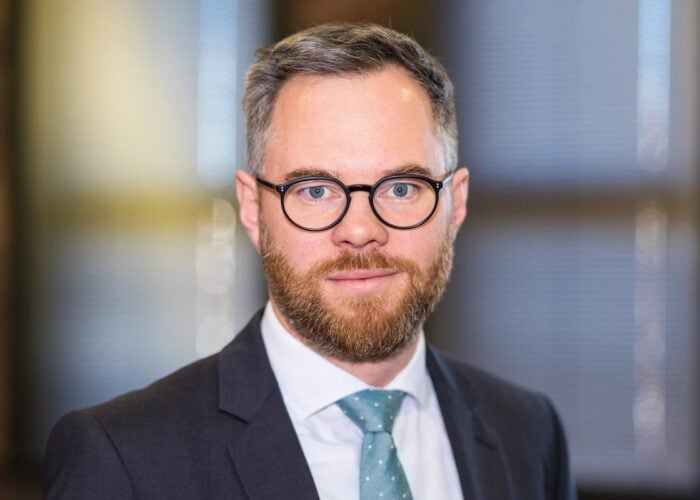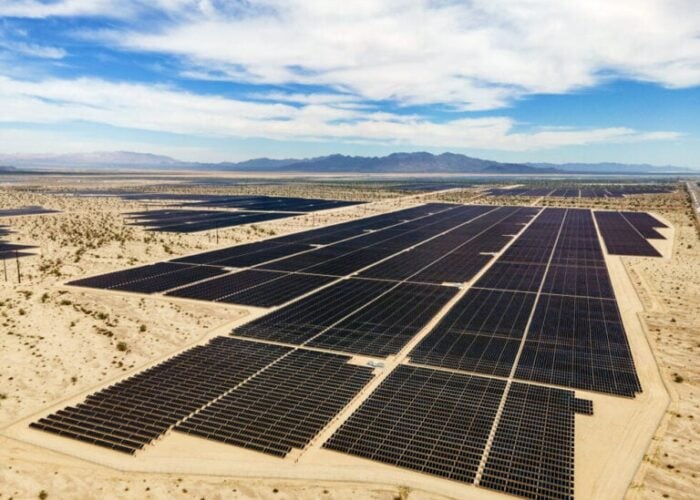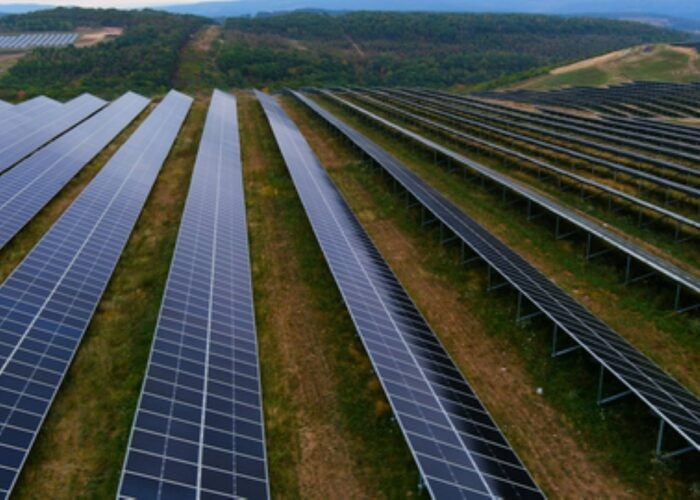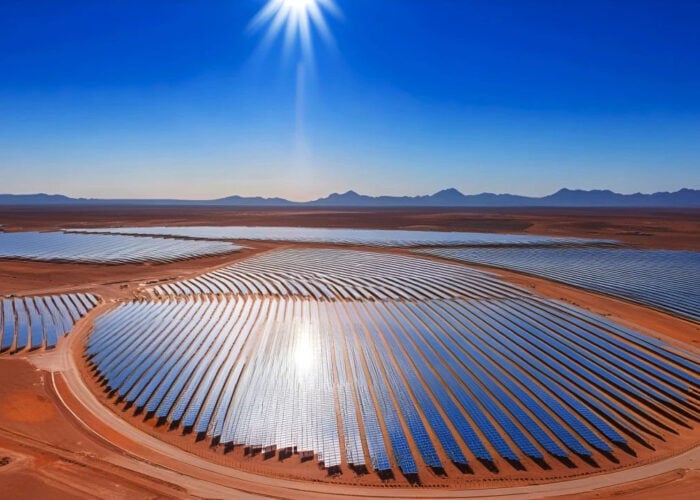
Legislation withdrawing vital tax credits has plunged the US solar market into turmoil, putting project deployments and manufacturing at risk. But, as Will Norman reports, despite the prospects of a downturn, the industry remains defiant over its long-term future.
Many didn’t think it would happen. Before the election, the US solar industry broadly thought the Inflation Reduction Act (IRA) would weather a second Trump administration. It wouldn’t make economic sense to scrap it, they said. Red states had benefited too much to ditch tax incentives. And besides, the legal complexity of repealing the bill would be too great. Those predictions were wrong.
Try Premium for just $1
- Full premium access for the first month at only $1
- Converts to an annual rate after 30 days unless cancelled
- Cancel anytime during the trial period
Premium Benefits
- Expert industry analysis and interviews
- Digital access to PV Tech Power journal
- Exclusive event discounts
Or get the full Premium subscription right away
Or continue reading this article for free
It’s now clear the White House is attacking renewable energy and the federal apparatus which sustained its growth over recent years.
With MAGA tanks parked firmly on its lawn, the path forward for the solar industry is uncertain. Alongside tariffs, sweeping changes at the Department of Energy and orders to clamp down on solar and wind permits, tax credits are on the chopping block.
The rules of the game have changed, but many of the facts haven’t. Energy demand will continue to grow, driven largely by data centres and the growth of AI. Fossil fuel emissions still cause climate change. Solar is the fastest-growing new source of US energy generation.
We spoke with leading US industry analysts, participants and lawyers to understand the state of play for the solar sector and look forward to what might come next.
The state of play – ITC, PTC
July’s budget reconciliation bill – the ‘One, Big, Beautiful Bill’ – introduced an early end to the 30% 48E Investment Tax Credit (ITC) and 45Y Production Tax Credit (PTC) previously available under the IRA.
Solar and wind projects that begin construction before 4 July 2026 – one year from when the bill became law – are eligible for the credit under current “safe harbour” regulations. Those that start construction after that date must be placed in service by 31 December 2027. Projects which begin construction within that 12-month window are not required to be in service by the end of 2027. Projects which began construction before 2025 are generally safe from repeals.
The safe harbour also protects projects from Foreign Entity of Concern (FEOC) restrictions, which prohibit exposure to financial backing or “material support” from Chinese firms (as well as Russian, Iranian and North Korean).
The dates are key. The safe harbour for the 30% ITC or PTC is contingent on the definition of “start construction”. Under the bill’s wording, that may require developers to spend 5% of the project’s total estimated cost by the deadline. They can also start “physical work of a significant nature” to access the safe harbour, “which can be something as simple as having a custom transformer made for you in a factory”, according to Christian Roselund, senior policy analyst at Clean Energy Associates (CEA), who spoke to us for this piece.
Bob Moczeluwski, director at accountancy and tax advisory firm Baker Tilly, says similarly. “Ordering transformers has been a traditional one because they’re [already] in some guidance on establishing the beginning of construction, and they’re bespoke.” We also heard that building maintenance roads for a project might count as “significant” physical work.
But the reconciliation bill’s definition of starting construction might become irrelevant. The law was signed on a Friday; on the following Monday, president Trump issued an executive order which could rewrite the rules.
‘Cruelty is part of the point’
The executive order gives the Treasury 45 days to assess stricter safe harbour rules than those in the bill. It wants to combat “artificial acceleration or manipulation” of safe harbour rules, and orders that “a substantial portion” of a project must be built for it to be eligible.
This targeted attack might dramatically reduce the number of solar projects that will secure safe harbour in the next year, with real impacts on deployments.
“The [order’s] full impact is hard to predict,” says Aaron Halimi, president and founder of US developer Renewable Properties. “One way or another, it’s going to change the economics of building solar.”
Roselund says: “That order will be a significant challenge for the industry. Our estimates were that there were 100GW of projects that planned to start construction by the end of the year, but now much of that is at risk.”
It’s not clear what a “substantial portion” of construction means. “The wording of the executive order suggests that you may have to do significant work on-site to claim start of construction,” Roselund says. He also sees a “significant risk” that the order could be applied retroactively.
Despite some speculation, Robert Romeshko, partner at law firm Husch Blackwell, says the administration would “have trouble” applying new guidance retroactively; “There’s relatively little precedent out there”. However, he says that as the guidance is under review, the industry shouldn’t assume it won’t change. “Certainly [there is] a line of precedent which says that if you’re on notice that they’re re-examining something, you [risk] having the rug pulled from under your guidance.”
The executive order represents the first move in a direct attack on clean energy, going beyond Congress’s provisions. At Trump’s behest, the Department of the Interior has also introduced tighter restrictions on permitting solar and wind on federal land, to combat what it calls “the Green New Scam”.
As Jigar Shah, former director of the Department for Energy’s Loan Programs Office (LPO), sums it up to us: “It feels intentional. It feels like the cruelty is part of the point of the whole thing. The problem is that once a bill passes, to then have an executive order that says we are going to deliberately put more uncertainty into the process on purpose – that feels personal. And that, I think, is the part that is the most upsetting. Because you’re talking about hundreds of thousands of people in the United States, millions, even, who are working every day to make sure that we have the essential electricity generation added to the grid to be able to meet our economic development goals. And what signal exactly is it that you’re sending to them about how important their role is in the energy system?”
You can read more of what Shah has to say at the bottom of this article.
‘Be prepared for an audit’
Whatever the language means, it seems certain there will be a rush to get projects moving before June 2026 and prove the start of construction.
“The plan was to lock in 100GW or more of projects in the next 12 months,” Roselund says. “Based on conversations with developers, we estimate that 30GW of projects have already locked in start of construction from the beginning of this year.
Aaron Halimi says the industry must “move quickly” and have “robust documentation to prove project eligibility before potential rule changes”.
Indeed, developers should “be prepared for an audit”, according to Romashko. “People need to assume someone’s going to want to look at that [documentation] at some point, and you don’t want to have holes in it.” He predicts that the IRS will increase enforcement on renewables, even as the Treasury itself is cut back. Given the “cruelty” on display against the industry already, it’s hard to argue.
But there may be workarounds.
“As smart as the politicians like to think they are, the tax professionals and industry leaders ultimately become a lot smarter in the whole process,” Moczeluwski says. “There are creative ways within the industry to set things up.”
Last year, overturning the “Chevron defence”, the US Supreme Court granted courts more freedom from federal agencies’ interpretations of ambiguous laws. With a federal government hostile to renewables – and a lot of ambiguity – this could benefit the industry, though its impact will likely be case-by-case.
“You can [now] look at any regulation, IRS regulations included, and ask how much water they really hold,” Moczeluwski says.
“Guidance is just guidance,” Romashko says, “and you’re always free to say we don’t think this meets the statute and try to take another position. But you assume risk by doing so.”
It’s another turn of the solarcoaster
This year will be a big year for new projects as the industry rushes to start building. After that, things start changing.
“2026 will likely be a big year for putting projects in service,” Roselund says. “And then in 2027, the changes made to eligibility for these tax credits will likely start to affect deployment levels. In 2028, all major market analysts expect to see a significant decline in deployment. And after that, the size of the market will depend on what deployment levels look like without the tax credits.”
“It’s another turn of the ‘solarcoaster’”, he continues. “There’s still a solar market without the tax credits. CEA’s analysis estimates that it is roughly half as big and it’s a lot more geographically focused in states that have renewable energy mandates.
“Based upon binding renewable energy mandates, we expect that the Northeast will still install solar; Minnesota will still install solar, for the same reasons; Colorado, New Mexico, and Nevada will also still install solar.
“Texas doesn’t have renewable energy mandates, so the market is more dependent on federal subsidies. FPL in Florida has plans to build a lot of solar, but we will see how changes in incentives affect that. There are large parts of the country, including the South, the plains states, and much of the Midwest, where the loss of incentives will likely affect the market more.”
Energy mix could become another divide in polarised modern America.
‘A flight to quality’
The industry will likely consolidate. Noam Yaffe, vice president at market intelligence firm Pexapark, expects big developers and investors to succeed and grow, while for smaller firms, “this is the most painful thing that you’ve experienced in the last decade plus. It’s in many ways catastrophic for these businesses.”
Aaron Halimi predicts a “flight to quality”. “Investors will prioritise experienced developers with proven track records,” he says. “In the short term, the uncertainty may put a lot of pressure on smaller developers, but I think any consolidation is going to make the solar industry stronger and prepared for an unsubsidised market.”
But changes to the solar industry have implications beyond its own immediate concerns.
“What we’re talking about today is powering the entire US economy. We’re no longer talking about the solar industry,” Jigar Shah tells us.
“AI, growth, manufacturing, all those priorities are at risk because of these dislocations in the market. It used to be that when we called things the ‘solarcoaster’, we were talking about the commercialisation of solar power. Today, we’re fully commercialised and actually providing essential services to the US economy.”
Some forecasts say that US electricity demand will grow by 50% by 2050, driven by transportation and data centres. The International Energy Agency (IEA) identified the US and China as the predominant development markets for data centres and AI. In Yaffe’s words, “Solar is the best” solution for cheap, fast power.
The US might have shot itself in the foot if these policy changes collapse the solar market as much as Roselund and others predict. On the other hand, demand from big tech and other industries won’t disappear overnight.
“I think [big tech companies] will continue to buy renewables,” Yaffe says. “It’s the right thing to do, and these companies genuinely want to reduce their carbon footprint.” This optimism will be tested in the coming months and years, as will the eco-conscious claims made by firms like Meta.
But it’s unlikely everyone will do the right thing. Markets don’t have a conscience, nor do businesses.
“I was talking to someone who was going to buy between 3-4GW of renewables in ERCOT over several years,” Yaffe says. “But now they’re building data centres and trying to co-locate them with gas plants. Renewables are a nice plus, but it makes no difference to them.”
We know that energy prices will go up as supply drops. The government will back more gas plants, which have a lead time of around seven years. We know some small developers will disappear. But demand for renewables won’t; states will keep mandating new clean energy and the industry will find ways to realise its projects. But this is only one side of the story.
Even bigger impacts to manufacturing
“We at CEA expect this bill to result in a decline in US solar deployment, but we expect even bigger impacts to clean energy manufacturing,” Christian Roselund says.
The roughly 50GW of US module manufacturing capacity represents millions in investment and thousands of jobs. But that expansion is under threat, too.
The 45X Advanced Manufacturing tax credit is preserved under the OBBB act, which accords with Trump’s stated aim to bring back American jobs, particularly manufacturing jobs.
But one industry analyst who spoke to us called this aim “doublespeak”, and the Solar Energy Industries Association (SEIA) previously warned the bill could risk over 300,000 jobs in the solar sector.
The problem is the FEOC restrictions. Projects directly owned by, under “effective control” of, or receiving “material assistance” from a designated foreign entity (read: Chinese entity) cannot receive the 45X credit. China and Chinese-controlled firms dominate over 80% of every stage of the solar supply chain, putting particular strain on the “material assistance” provision.
“If you’re making modules, you have to get your cells from a non-FEOC company in order to access 45X,” Roselund explains. US cell capacity is currently below 10GW, massively behind module capacity.
“And if you’re making cells, you have to get your wafers from a non-FEOC company, and there is a limited supply of those that is both non-FEOC and not subject to AD/CVD duties,” he continues. There is currently no US wafer manufacturing capacity.
Elissa Pierce, research analyst at Wood Mackenzie, said in July: “Despite billions in tariffs and years of diversification efforts, Chinese companies still control manufacturing through regional subsidiaries. When Malaysian glass suppliers and Vietnamese frame manufacturers are Chinese-owned operations, we’re not achieving energy security. We’re simply paying higher prices for the same supply chain risk.
“These new market distortions could ultimately harm [US] renewable energy deployment while potentially precluding domestic manufacturers from receiving the 45X tax credits due to the FEOC restrictions.”
As with the developer market, big players will likely weather the storm and secure the credits.
First Solar will likely be able to secure the credit, as its cadmium telluride (CdTe) technology is largely isolated from Chinese supply and it’s well established in the US market. Qcells’ integrated factory in Cartersville, Georgia, will also likely receive the credit, as it can access non-Chinese supply deals through its Korean owner, Hanwha.
Indian firms, like Waaree – which owns a module production facility in Texas – will be able to import Indian cells and secure the 45X credit for that facility.
“CEA expects the FEOC-owned companies to divest a portion of their ownership rather than have to close down factories, which can’t compete without the 45X”, Roselund says.
More concerningly, he says, “To build and operate a solar factory in the US, you need to be able to sell the goods that you make in that factory into the US market. There is no business case to export overseas. That means that if or when the domestic solar market shrinks, domestic solar factories are at risk.”
When the ITC and PTC phase out, they will take the domestic content bonus credit with them – Roselund says this removes the financial incentive to buy domestic modules. Coupled with inability to access the 45X credit, a number of US module factories may be stuck in limbo.
The potential fate of those factories is hardly rosy, with a shrinking market and no federal support. And there’s a kicker.
“Foreign entity rules only come into play when you’re trying to qualify for the ITC or the PTC,” Roselund says. “But once those incentives phase out, companies will naturally look to source modules from wherever they can get the best price globally.”
This could result in uncompetitive US products and all but a few leading producers closing down or selling up.
Once again, this is prediction, not prophecy. Halimi says: “In general, developers are going to prioritise US-owned manufacturers with documentation that they’re free of FEOC concerns.” He continues: “Of course, everyone’s going to have that strategy, pushing up module prices. If the economics are better procuring equipment from outside the US, we’ll have to do that to reduce our costs and, ultimately, electricity prices.”
Supply chain, pricing and tariffs
Wood Mackenzie says the “complex web of tariffs and policy restrictions” is reshaping global solar supply chains.
Modules will get more expensive, adds Mike Hall, chief executive of solar supply chain platform, Anza. “It’s possible that we’ll see, over the coming weeks and months, a pricing spread between Chinese and non Chinese companies. We haven’t seen it yet, but that could emerge.”
As developers rush to buy modules before the bill’s deadlines, Hall says he’s seen a divergence in strategy. Some “[who] want to purchase from the handful of suppliers they feel confident are not going to be subject to FEOC” have “focused on non-Chinese modules”, says Hall. “But we also see a lot of companies purchasing from Chinese [manufacturers] now because they’re concerned about their ability to do so in the future.”
Trump’s “reciprocal” tariff regime will also make solar products more expensive. That increase will likely be passed on in higher power prices.
The Middle East, North Africa and Turkey are expected to become alternative supply sources. However, Wood Mackenzie said most planned capacity there will not be online until 2026 at the earliest, and most is Chinese-owned, which may prevent developers using those products from accessing tax credits thanks to FEOC.
‘We want to do the right thing’
“I think the industry can survive this. We’ve survived storms before, we’re going to get through it,” Yaffe says. “The difference with this industry and other industries is we’re all here because we want to make a difference and do the right thing.”
Beyond the specifics of market dynamics and uncertain policy, the industry believes it will continue to progress. “The US solar and storage industry can certainly stand on its own without subsidies. I wish the fossil fuel industry could say the same after over 100 years of subsidies,” Halimi says. “AI data centre demand is too high, and with or without subsidies, solar is still going to be the fastest and cheapest way to meet that demand. Compared with gas, solar and wind are still the least expensive source of energy, even without subsidies, and there’s a five-year wait for natural gas turbines.”
Big utilities will also still set and meet green energy targets, states will mandate renewables and companies have international emissions targets they’ll be unlikely to abandon. “A significant portion of the country lives in states that have binding aggressive renewable energy mandates,” Roselund concludes.
But rose-tinted glasses serve nobody. The situation has changed, and the government has made moves to directly hamstring renewables, particularly solar energy. In a few short months, the industry is facing the removal of mechanisms which have enabled its recent boom.
Yaffe is right. The difference between renewables and other energy industries is the urge to “do the right thing”—to transition away from fossil fuels and combat man-made climate change. Can you trust a market to do the right thing? What about one where sourcing and permitting for renewables are deliberately made difficult? The US is the second-highest carbon emissions producer and the largest economy in the world—what it does matters.
“This is my hot take: I think we need to get away from government intervention in renewables,” Yaffe says at the end of our conversation. “I think this could be when the history books say, ‘this was the beginning of when renewables broke free, became a thriving and scalable industry.’ I don’t think we can rely on the government anymore. I think the uninterrupted free market can absolutely create incredible things, like a renewables boom.”
The same free market drove the climate change that necessitates renewables, and big fossil fuel firms like bp and Shell have rowed back on energy transition commitments under shareholder pressure, putting short-term profit over long-term priorities. They never drove the renewables market, but they show the priorities of some market forces. Then again, Yaffe is right that the industry can’t rely on this particular government, so maybe it’s better off on its own two feet.
Uncertainty is the operative word, for now. Abigail Ross Hopper told PV Tech Power: “Here’s what I know to be true—the solar and storage industry is resilient. Our industry has a value proposition no other sector can match: clean, fast, local power that lowers costs and boosts resilience.
“Americans will still demand energy choices, and the solar and storage industry will continue to deliver them.”
Plenty of capital, no projects to invest in
The veteran clean energy entrepreneur Jigar Shah speaks to Ben Willis about the impact of recent legislation on investment
The term ‘solarcoaster’ is well known in PV industry circles. It is popularly used to describe the highs and lows of a technology that, in most markets where it has appeared, has been supercharged by government backing of some kind before plunging to earth again as that support is withdrawn.
The solar industry has been around long enough now to see that the dips in the ride usually even out and eventually return to some kind of upward trajectory, as the economics of PV, especially coupled with increasingly cost-effective battery storage, win the day. Often, the second wave of growth is more sustainable than the first, as it is less cuopled to the whims and shifting priorities of politics.
According to US clean energy veteran, Jigar Shah, the highs may yet come again for the US solar business, but right now it’s hard to look beyond the current crisis. The immediate challenge for solar industry stakeholders is weathering what Shah says looks like a personal, indeed cruel, attack on their business.
“We can talk about the longer term in rosy ways, in terms of the continuing cost reduction of solar and battery storage,” he says. “But, right now, developers have a hard time keeping their promises to investors because they have a president in place who’s not honouring deals made with the legislators that passed the bill. I thought we had a deal when the bill was signed. But then, right after, the President came out and said I’d like to create a whole bunch of additional confusion.”
Shah is referring to the executive order issued only days after the passing of the “one big beautiful bill”, the budget reconciliation package that has rolled back much of the support underpinning the US clean energy sector’s rapid advances in recent years.
As explored in our main feature, the bill and subsequent executive order have created multiple layers of complexity and anxiety for US clean energy businesses as investors, developers and the wider supply chain scramble to understand what the new rules mean for them.
Of particular concern to Shah is the question of what energy investors will do with capital that is still looking for a home, regardless of recent political events. Even technology-agnostic energy investors will find life difficult because the alternatives for their money to clean energy—coal and natural gas—lack shovel-ready projects ready for investor dollars.
“Investors feel like they are not being given clear direction as to what to invest in,” says Shah. “Even if you’re talking to investors who have no climate agenda, they still need projects that have met the checklist. And what you find is that most of the natural gas projects in the United States have not met the checklist. They’re still three years away from having all their paperwork in place. So if you’re in the business of investing capital, and your bosses have given you US$50 billion to invest in clean energy or whatever it is, they’re saying, ‘Why have you not put the money out the door?’ Everybody has to put money out the door.
Right now, all eyes are focused on the US Treasury’s response to Trump’s executive order and how that will be implemented. The 45-day deadline given to the Treasury was due to pass after this journal went to press. Once the new rules are known, there will be a period of time for them to be implemented and, most likely, court challenges, says Shah.
“In the meantime, there are many electric utility companies and others saying to the administration, hey, if you mess with these rules in a way that will make it difficult for us to deploy, then we may, in fact, have rolling blackouts,” Shah warns. “So you need to be careful with how you do this, because if you do this incorrectly, then we will not be able to maintain service. We understand that you think that the solar industry is self-interested, but we, as the utility industry, are not self-interested. We’re happy to install coal or natural gas or whatever it is, but we’re just telling you that those are not options that are ready in the near term.”
A further irony not lost on Shah is that if the net intention of federal policy is to push utility investors towards coal or gas projects, the result will be further reliance on China as the source of the necessary hardware.
“Many of those supply chains … are coming from China,” Shah says. “I mean, the US doesn’t manufacture coal components anymore, right? So we would have to import Chinese coal components.
Read more about whether there are any silver linings to come from the latest shifts in US policy here, and how the OBBB act will affect the country’s storage sector here.






